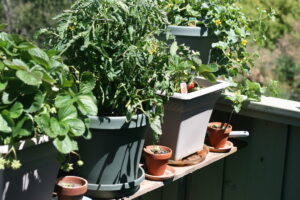
Article-at-a-Glance
-
Understand the transformative impact of biochar on soil health and tomato plant vitality.
-
Learn how to select the appropriate type of biochar for your tomato garden.
-
Discover the optimal timing and methods for applying biochar to your soil.
-
Find out the right amount of biochar to use for the best results.
-
Gain insights on monitoring your tomato plants’ response to biochar application.
Deciphering Biochar Properties for Tomato Success
When it comes to giving your tomatoes a robust start, few soil amendments can match the effectiveness of biochar. This charred organic matter is like a superfood for your garden’s soil, boosting fertility and water retention while encouraging a thriving ecosystem of beneficial microorganisms. But not all biochar is created equal, and understanding its properties is key to unlocking its full potential for your tomatoes.
Finding Your Perfect Match: Types of Biochar
Before you get your hands dirty, let’s talk about the types of biochar. Depending on the feedstock (the material from which the biochar is made) and the process used to create it, biochar can have varying effects on your soil and plants. Common feedstocks include wood chips, agricultural waste, and even manure. The process—whether it’s fast or slow pyrolysis, gasification, or hydrothermal carbonization—also influences the final product’s characteristics.
The different types of biochar available for tomato plants, as indicated by the research, include:
-
Wood Biochar: Derived from the pyrolysis of wood biomass, wood biochar is one of the common types used in agriculture. It has been studied for its effects on mitigating drought and salt stress in tomato seedlings, showing potential benefits in improving plant growth and physiology under stress conditions.
-
Poultry Biochar: Made from poultry manure, this type of biochar is another option for tomato cultivation. Similar to wood biochar, poultry biochar has been investigated for its ability to alleviate drought and salt stress in tomato seedlings, suggesting its utility in enhancing plant resilience to adverse environmental conditions.
-
Biochars from Various Biomass Sources: It’s important to note that biochar can be produced from a wide range of organic materials beyond wood and poultry waste. This includes agricultural residues, bamboo, and other plant materials. The specific effects of these biochars on tomato plants can vary based on their source material and pyrolysis conditions, influencing factors such as nutrient content, pH, and porosity.
Each type of biochar has unique properties that can influence soil quality, plant growth, and stress resistance differently. When choosing a biochar for tomato plants, consider factors such as the source material, pyrolysis temperature, and the specific needs of your soil and plants.
Analyze and Decide: Biochar Characteristics to Consider
The best type of biochar for tomato plants is one that is used in moderate concentrations and potentially derived from specific sources like bamboo. Research indicates that biochar can significantly enhance the growth and development of tomato seedlings, improve soil quality, increase tomato production, and even offer economic benefits when used with reduced nitrogen (N) fertilizer applications.
Bamboo Biochar for Enhanced Growth and Fruit Quality: Research on bamboo biochar pyrolyzed at low temperatures showed positive effects on tomato plant growth and fruit quality. This suggests that the source of biochar and the pyrolysis temperature can influence its effectiveness. Bamboo biochar, in particular, was found to improve plant growth and fruit quality, indicating that it could be a favorable choice for tomato cultivation.
Remember, the goal is to create a living soil, teeming with microbes that will support your tomato plants from seedling to harvest. If bamboo biochar is not available, then the best type of biochar for your tomato plants is one that is applied at appropriate concentrations and derived from an organic feedstock.
Mastering Biochar Application
Timing is Everything: When to Add Biochar
The best time to add biochar to your garden is before planting your tomatoes. This allows the biochar to integrate with the soil and begin interacting with the soil’s nutrients and microbiology. Ideally, apply biochar a few weeks in advance to give it time to ‘charge’—a process where biochar absorbs nutrients from compost or soil before it’s ready to support plant growth.
The Method Matters: Techniques for Biochar Integration
How you add biochar to your soil can make a big difference. Here are some techniques:
-
Direct Mixing: Combine biochar directly with your soil or compost at a 5-10% ratio by volume.
-
Top Dressing: Spread biochar on the surface of your soil and gently rake it in.
-
Slurry Method: Mix biochar with water to create a slurry, which can be poured around the base of your plants.
Each method has its benefits, but I find direct mixing of pre-charged biochar to be the most effective for ensuring an even distribution throughout the soil.
Quantity Quandaries: Determining the Right Amount of Biochar
Figuring out how much biochar to use can be a bit of a puzzle. Too little and you won’t see significant benefits; too much could potentially alter soil dynamics in a way that’s not beneficial. A good rule of thumb is to aim for a biochar application of about 5-10% of the soil’s volume. For a standard garden bed, this translates to about 1 inch of biochar over the surface before mixing it into the top 6-8 inches of soil. It’s essential to get this right because balance is the key to a thriving tomato patch.
Monitoring and Managing Biochar-Empowered Tomato Plants
After incorporating biochar into your garden, it’s not a ‘set it and forget it’ situation. You’ll want to keep a close eye on how your tomatoes are responding. Look for signs of improved growth and vigor. A successful biochar application often results in healthier, more resilient plants. Keep an eye out for lusher foliage, more robust stems, and an increase in fruit production. These are all signs that your biochar is working its magic underground.
However, if you notice any unexpected changes, like yellowing leaves or stunted growth, it might be time to reassess your soil’s balance. This could be an indication that the pH level of the soil has shifted or that nutrients are not being cycled properly. In this case, you may need to adjust your gardening strategy.
It’s also worth noting that the benefits of biochar can continue for multiple growing seasons, so it’s a long-term investment in your garden’s health. Because of this, monitoring should be an ongoing process, allowing you to fine-tune your approach with each passing year.
Nourishment and Care: Post-Application Tips
Once biochar is a part of your soil, you’ll want to ensure your tomatoes are getting all the nutrients they need to thrive. This means adopting a slightly different approach to fertilization. Biochar can hold onto nutrients, releasing them slowly over time, so you might find you need to fertilize less frequently. On the flip side, because it’s so good at retaining nutrients, you might need to initially add a little more fertilizer to ‘charge’ the biochar, ensuring there’s enough to go around.
Watchful Gardening: Observing Plant Responses to Biochar
Observing your tomato plants is like having a conversation with them. They’ll tell you how they’re feeling about the biochar through their growth and fruiting patterns. Watch for changes in the color and texture of the leaves, the firmness of the stems, and the size and taste of the tomatoes. These cues will guide you in adjusting your care routine to suit their needs. Remember, gardening is a dynamic process, and the best gardeners are those who listen to their plants and adapt accordingly.
Unearth the Secrets of Biochar for Robust Tomato Growth
Biochar is a bit of a secret weapon in the gardening world. Its porous nature not only improves soil structure but also encourages beneficial microbial activity. This means that your tomato plants can enjoy a more aerated root environment and better access to nutrients. But it’s not just about what biochar adds to the soil; it’s also about how it transforms it. By increasing the soil’s water retention capacity, biochar helps to ensure that your tomatoes can withstand those hot, dry spells that can sometimes take gardeners by surprise.
What Is Biochar and Why Is It a Game-Changer for Tomatoes?
So, what exactly is biochar? It’s essentially charcoal that’s been specifically made for use in soil enhancement. It’s created by burning organic material in a controlled environment with limited oxygen—a process called pyrolysis. This produces a stable form of carbon that can endure in soil for centuries. For tomatoes, biochar means better root growth, enhanced nutrient uptake, and greater resistance to soil pathogens. All of these factors contribute to a more bountiful and delicious tomato harvest.
But why is biochar such a game-changer? Because it fundamentally improves the structure and fertility of the soil. It’s not just an additive; it’s a soil conditioner that transforms your garden bed into a haven for plant growth. The use of biochar has been found to promote seedling development and improve disease resistance. A study found that biochar promotes the development of tomato seedlings and does not have any negative effect on beneficial soil microorganisms, such as Bacillus spp. and Trichoderma spp., which are important for plant growth and disease resistance. The study suggests that biochar concentrations ranging from 1% to 10% are suitable for promoting seedling development.
An additional study conducted in Northwestern China demonstrated that adding biochar to the soil, especially at a rate of 50 tons per hectare, while reducing nitrogen fertilizer by 24%, resulted in the greatest tomato yield. This was attributed to increased soil enzyme activity, microbial abundance, and improvements in leaf gas exchange parameters and biomass. The study highlights the potential of biochar to reduce the need for nitrogen fertilizer, thereby offering both environmental and economic benefits.
Critical Soil Conditions for Maximum Biochar Benefits
To get the most out of biochar, you’ll want to ensure your soil is in prime condition. This means having a balance of clay, silt, and sand for good texture, as well as a healthy dose of organic matter. Your soil should be well-draining yet able to retain moisture—conditions that biochar can help create and maintain. Moreover, the pH should be slightly acidic to neutral, which is the sweet spot for tomato plants. If your soil is heavily clayey or sandy, biochar can help to moderate these extremes, creating a more hospitable environment for your tomatoes.
The important characteristics of biochar to consider for your soil type and tomato success include:
-
Particle Size: Smaller particles can be mixed more thoroughly with soil, affecting more extensive root systems.
-
Porosity: Highly porous biochar provides homes for microorganisms and space for water and nutrient retention.
-
pH Level: Tomatoes prefer slightly acidic to neutral soil, so choose a biochar that will help maintain this balance.
Embracing biochar in your tomato garden can lead to remarkable improvements in plant health and yield. With the right approach to selection, application, and management, you’ll be well on your way to enjoying the fruits of your labor—literally. Happy gardening!
FAQ
Can Biochar Be Used with All Types of Tomatoes?
Yes, biochar is beneficial for all tomato varieties, from cherry to beefsteak. The key is to match the biochar to your soil’s needs and ensure it’s properly integrated. Whether you’re growing heirlooms or hybrids, biochar can help improve soil structure, water retention, and nutrient availability, leading to healthier plants and better yields.
How Often Should Biochar Be Reapplied to Tomato Gardens?
Biochar is a long-lasting amendment, so reapplication might only be necessary every few years or when you notice a decline in soil quality. If you maintain a healthy composting routine and good soil practices, the biochar you’ve added will continue to benefit your soil without the need for frequent reapplication.
Does Biochar Affect Tomato Taste or Nutritional Content?
Biochar can actually improve the taste and nutritional content of tomatoes by enhancing nutrient uptake. Plants grown in biochar-amended soil often have access to a more balanced supply of essential nutrients, which can lead to tastier and more nutritious fruits.
Can I Make Biochar at Home for My Tomato Plants?
While it’s possible to make your own biochar, it requires careful control of the burning process to avoid creating pollutants, so it’s often easier and safer to purchase commercially produced biochar. If you do decide to make your own, ensure you’re doing so in a well-ventilated area and following safety guidelines.
Are There Any Risks to Using Biochar for Tomato Plants?
When used correctly, biochar is safe for tomato plants. However, using too much or using biochar that hasn’t been properly processed can lead to issues with soil balance. It’s important to source your biochar from a reputable supplier and to use it as part of a balanced soil management plan.



